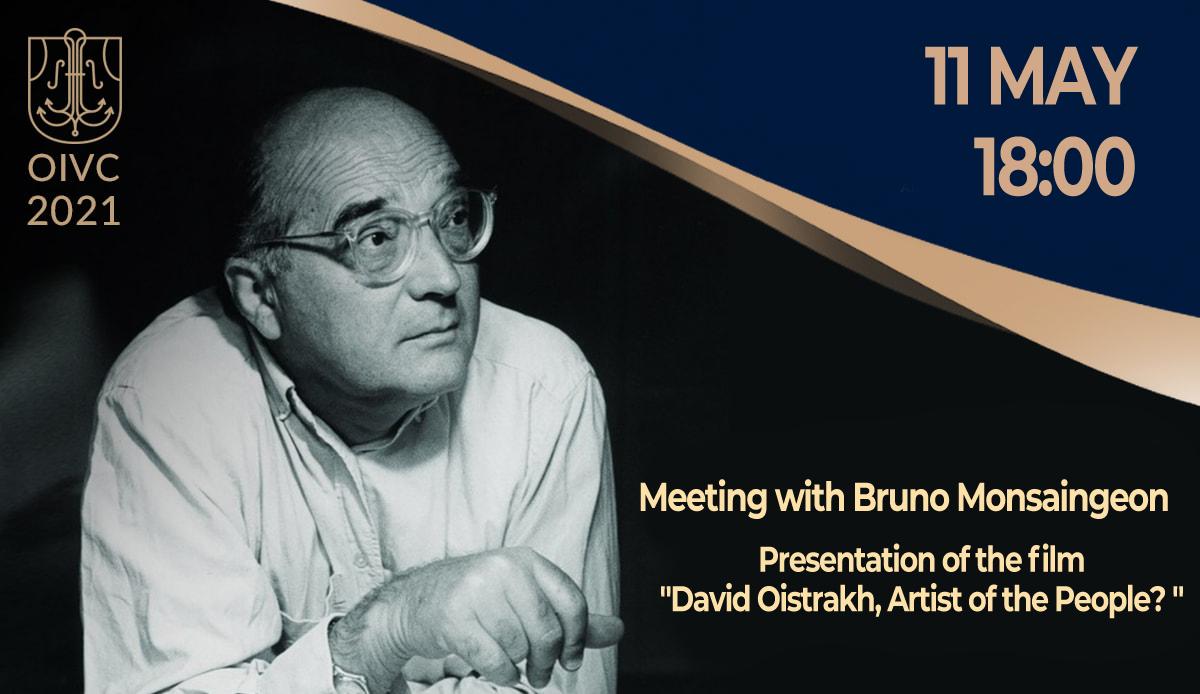A very special guest is coming to Odesa International Violin Competition. The author of cult documentaries about Richter, Oistrakh, Menuhin and other outstanding musicians will join the celebration of the 150th anniversary of Peter Stolyarsky and the Jury team! On May 11 Bruno Monsaingeon will present his film "David Oistrakh, Artist of the People?"
The meeting will take place at the Grand Hall of Odessa State Nezhdanova Music Academy as a part of Odesa International Violin Competition programme.
Bruno Monsaingeon is a Paris-based concert violinist who, while still active in the field of performance has, in the last thirty years, devoted a large part of this time to the making of historical films on famous musicians.
He has directed films on and about some of the major musicians of our time, Nadia Boulanger, Yehudi Menuhin, Murray Perahia, Glenn Gould, Sviatoslav Richter, Viktoria Postnikova, Guennadi Rojdestvenski, Michael Tilson Thomas, Zoltán Kocsis, Friedrich Gulda, Paul Tortelier, Julius Katchen, Dietrich Fischer-Dieskau, David Oïstrakh, Julia Varady, amongst many others.
His long association with Yehudi Menuhin and Glenn Gould have been remarkable and have led to the production of numerous films on various subjects with these two musicians. Two of these productions in particular, The Open Wall, Menuhin in China and The Goldberg Variations, have gained worldwide acclaim.

After several years of research, Bruno Monsaingeon found, restored and edited a vast amount of archival footage on the great Soviet violinist David Oistrakh. In addition to the three programmes of The David Oistrakh Collection, based on rare concert material filmed in the Soviet Union, Monsaingeon recently directed a major profile of the violinist, entitled "David Oistrakh, Artist of the People?" (West Flanders International Art Film Festival Prize, Knokke Belgium, 1995; Charles Cros Academy Video Prize, 1998).
The film which will be presented to Odessa audience is about famous odessan, one of the supreme violinists of our era David Oistarkh. Born in 1908, David Oistrakh lived through the troubled years which preceded and followed the October Revolution, years of starvation, war and terror. As if it provided him with some kind of personal refuge, his art, intense but serene, did not seem to be affected, even though he did have to wait a long time for international recognition which was delayed by the second world-war and the political circumstances of the post-war period.
... I have for a long time born in my mind the project of a film about David Oïstrakh. Carrying it out was in fact the result of an extravagantly long process, which began in Moscow as early as 1979...
Bruno Monsaingeon
David Oistrakh, who had studied in Odessa with Pyotr Stoliarsky, was part of the long tradition of the Russian violin school. He, in turn, had become the true founder of the Soviet school which would ultimately astound the musical world by sending its best representatives to prestigious international violin competitions abroad.
Oistrakh's playing was not so much marked by brilliance than by lyricism, plenitude, roundness of sound; by the unbelievable bite of his bowing , its sharpness and clarity; his ability to draw long bows on even the shortest of notes without the slightest tension; his beautifully fleshy, supple left hand with its glorious vibrato capable of an infinite variety of shades.

Photo: Bruno Monsaingeon archive
Monsaingeon's film which we are going to see on May 11 is definitely unique due to the director's deep understanding of his characters, the environment in which they lived and worked:
I know several types of great violinists: some are the wonderful but unimaginative calculators, who play for the sake of effect, a splendid effect admittedly, yet each time reproduced in the same perfectly predictable way. Others, who abandon themselves to the fantasy of the moment and who, for lack of discipline, indulge in purely whimsical self-utterances. And then, there are those who succeed in striking an ideal balance between the utterly predictable and the utterly abandonned, between rigor and freedom. David Oïstrakh was the incandescent model of the latter type, the very example of purity and of musical integrity.
Bruno Monsaingeon





















